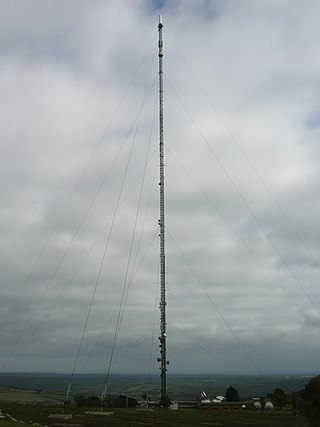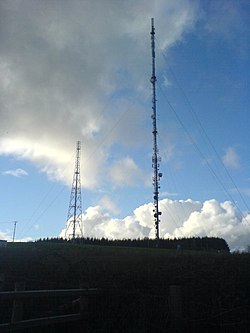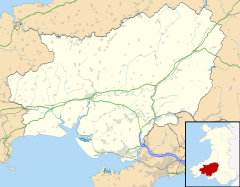
The Mendip transmitting station is a broadcasting and telecommunications facility on the summit of Pen Hill, part of the Mendip Hills range in Somerset, England, at 305 metres (1,001 ft) above sea level. The station is in St Cuthbert Out civil parish, approximately 2 miles (3.2 km) north-east of Wells. Its mast, 293 m (961 ft) high, was built in 1967 and is the tallest structure in South West England. The mast broadcasts digital television, FM analogue radio and DAB digital radio, and had broadcast analogue colour television from 1967 until 2010.
Digital terrestrial television in the United Kingdom encompasses over 100 television, radio and interactive services broadcast via the United Kingdom's terrestrial television network and receivable with a standard television set. The majority of digital terrestrial television (DTT) services, including the five former analogue channels, are broadcast free-to-air, and a further selection of encrypted pay TV services are also available. Freeview is the only DTT service since Top Up TV closed in 2013.

The Preseli transmitting station is a broadcasting and telecommunications facility on the eastern end of the Preseli Mountains, close to the villages of Crymych and Pentre Galar in Pembrokeshire, Wales. It is owned and operated by Arqiva.

The Kilvey Hill transmitting station was originally built at the summit of Kilvey Hill in Swansea, Wales, by the BBC in 1967 as a relay for VHF and UHF television. VHF television came on air a few months before the UHF services. As built, the station did not radiate VHF FM radio, this was added later. Currently, the hill's transmitters cater for viewers and listeners in Swansea, Neath Port Talbot and Llanelli. The station is owned and operated by Arqiva.
The Brecon transmitting station was originally built by the IBA in 1970 as a relay for VHF 405-line analogue television: one of the last 405-line TV stations to be built in Britain. As built, it consisted of a 46 m guyed lattice mast carrying the aerials at the top. This structure was built about 300 m NW of Slwch Tump Iron Age hill fort on the slopes of a 240 m hill known as "The Slwch" overlooking the town. The VHF television feed was provided off-air from Abergavenny, about 25 km to the southeast - itself an off-air relay of St. Hilary near Cardiff.
The Pontardawe television relay station was originally built in 1974/1975 as a relay for UHF analogue television. It consists of a 45 m self-supporting lattice mast standing on a hillside which is itself about 160 m above sea level. Currently, the transmitters cater for most of the digital terrestrial TV subscribers in the towns of Pontardawe and Alltwen and in the nearby villages of that section of the Tawe valley. The transmission station is owned and operated by Arqiva.
The Alltwen television relay station is sited on a hill to the southwest of Pontardawe in the Swansea Valley, at least a kilometre away from the village of Alltwen from which it takes its name. It was originally built in the late 1980s as a fill-in relay for UHF analogue colour television. It consists of a 17 m self-supporting lattice mast standing on Craig Glyn Meirch, a hillside which is itself about 140 m above sea level. The transmitters are beamed northwards and eastwards to cater for those digital terrestrial TV subscribers in the towns of Pontardawe and Alltwen who for reasons of geography can't get a signal from the much bigger and more powerful Pontardawe transmitter. The Alltwen transmission station is owned and operated by Arqiva.
The Craig-Cefn-Parc television relay station is sited on Mynydd Gelliwastad to the west of Clydach in the Swansea Valley. It was originally built in the 1980s as a fill-in relay for UHF analogue colour television. It consists of a 17 m self-supporting lattice mast standing on land which is itself about 160 m above sea level. The transmissions are beamed to the northwest to avoid cross-channel interference with the Alltwen transmitter which is about 4 km to the northeast and which uses the same frequencies. The Craig-Cefn-Parc transmitter is owned and operated by Arqiva.
The Mynydd Emroch television relay station is sited on the eponymous hill to the east of Port Talbot. It was originally built in the 1970s as a fill-in relay for UHF analogue television. It consists of a 25 metres (82 ft) self-supporting lattice tower standing on a hillside which is itself 600 ft above sea level. The transmitters are beamed southwards to cater for those digital terrestrial TV subscribers in Port Talbot and Margam which for reasons of geography can't get a signal from the Kilvey Hill transmitter across the bay at Swansea. The Mynydd Emroch transmission station is owned and operated by Arqiva.
The Briton Ferry television relay station is sited on a hill to the east of Briton Ferry. It was originally built in the 1970s as a fill-in relay for UHF analogue colour television. It consists of a 25 m self-supporting lattice mast standing on a hillside which is itself about 180 m above sea level. The transmitters are beamed towards the southwest and northwest to cater for those digital terrestrial TV subscribers in Briton Ferry and western Neath which for reasons of geography can't get a signal direct from the Kilvey Hill transmitter at Swansea nor from the relay transmitter at Neath Abbey across the valley. The Briton Ferry transmission station is owned and operated by Arqiva.
Cilfrew television relay station is sited on a hill south of the village of Tonna, at least 2 km across the valley from Cilfrew in the Neath Valley. It was originally built in 1981 as a fill-in relay for UHF analogue colour television serving the villages of Cilfrew itself, Aberdulais and Tonna. It consists of a 30 m self-supporting lattice mast standing on land which is itself about 80 m above sea level. The transmissions are beamed to the north. The Cilfrew transmission station is owned and operated by Arqiva.
The Efail Fach television relay station is sited on a hill west of the villages of Efail Fach, Cwm Pelenna and Tonmawr. It was originally built in the 1980s as a fill-in relay for UHF analogue colour television serving all of those settlements. It consists of a 15 m self-supporting lattice mast standing on a hill which is itself about 160 m above sea level. The transmissions are beamed to the east towards the Pelenna valley. The Efail Fach transmission station is owned and operated by Arqiva.
The Abergavenny transmitting station was originally built by the IBA in 1969 as a relay for BBC and ITV VHF 405-line analogue television. It consists of a 46 m guyed lattice mast carrying the aerials at the top. This structure was built on a 440 m hill known as Gilwern Hill overlooking the towns of Gilwern and Abergavenny in Monmouthshire, South Wales. The band III VHF television feeds were provided off-air from St. Hilary and Wenvoe, both near Cardiff.

The Long Mountain transmitting station is sited on a 400 metres (1,300 ft) ridge about 4 kilometres (2.5 mi) east of Welshpool in Powys, Mid Wales and has been broadcasting UHF terrestrial TV and VHF FM radio services since the late 1970s. The site has a self-supporting 170' (52 metre) high lattice steel mast and was fed with an SHF link from Blaenplwyf via Llangurig. Despite not taking its signal off-air, it was originally classed as a 625-line UHF TV relay of Blaenplwyf.
The Builth Wells television relay station is sited on high ground to the north of the town of Builth Wells in Powys, South Wales. It was originally built in the 1980s as a fill-in relay for UHF analogue colour television. It consists of a 25 m self-supporting lattice mast standing on a hillside which is itself about 230 m above sea level. The transmissions are beamed southwards. The Builth Wells transmission station is owned and operated by Arqiva.
The Llansawel television relay station is sited on high ground to the north of the village of Llansawel in Carmarthenshire, South Wales. It was originally built in 1986 as a fill-in relay for UHF analogue television. It consists of a 17 m wooden telegraph pole standing on a hillside which is itself about 160 m above sea level. The transmissions are beamed southwards. The Llansawel transmission station is owned and operated by Arqiva.
The Talley television relay station is sited on high ground to the north of the village of Talley in Carmarthenshire. It was originally built in 1986 as a fill-in relay for UHF analogue television covering the community of Talley. It consists of a 17 m wooden telegraph pole standing on a hillside which is itself about 220 m above sea level. The transmissions are beamed southwest and northwest to cover all the small settlements of the area and to provide a signal for the Llansawel repeater about 5 km to the northwest. The Talley transmission station is owned and operated by Arqiva.
The Brechfa television relay station is sited on high ground to the east of the village of Brechfa to the northeast of Carmarthen. It was originally built in the 1980s as a fill-in relay for UHF analogue colour television covering the communities of Brechfa, Horeb and Aber Goleu. It consists of a 12 m self-supporting lattice steel mast standing on a hillside which is itself about 290 m above sea level. The transmissions are beamed northeast to cover all these targets. The Brechfa transmission station is owned and operated by Arqiva.
The Cilycwm television relay station is sited on high ground to the east of the village of Cilycwm to the north of Llandovery in Carmarthenshire, South Wales. It was originally built in 1987 as a fill-in relay for UHF analogue colour television covering the communities of Cilycwm and Rhandirmwyn. It consists of a 17 m self-standing lattice steel mast standing on a hillside which is itself about 190 m above sea level. The transmissions are broadly beamed west and east to cover the targets. The Cilycwm transmission station is owned and operated by NTL.
The Rhayader television relay station is sited on high ground to the northeast of the town of Rhayader, south Wales. It was originally built in the 1980s as a fill-in relay for UHF analogue television covering the communities of Rhayader and St. Harmon. It consists of a 45 m self-supporting lattice steel mast standing on a hillside which is itself about 345 m above sea level. The transmissions are beamed southwest and northwest to cover its targets. The Rhayader transmission station is owned and operated by Arqiva.





